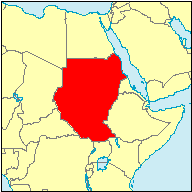Sudan |
Disaster Assistance at a Glance
Recent Disaster Declarations:
Complex emergency
OFDA Response:
Agriculture and food security, capacity building, economy and market systems, emergency relief supplies, health, humanitarian coordination and information management, logistics, nutrition, protection, shelter, water, sanitation, and hygiene
Latest OFDA Report:
Sudan Complex Emergency Situation Report #8 (74kb PDF)
OFDA FY 2008 Funding Guidance for Darfur:
FY 2008 Funding Guidance for Darfur (44kb PDF)
|

|
|
|
Most Recent Disaster Declaration:
Complex Emergency, 10-16-2008
In FY 2009, Sudan continues to face conflict, large-scale displacement, and insecurity countrywide. Since 2003, a complex emergency in Sudan’s western region of Darfur has displaced nearly 2.5 million people and affected more than 4.5 million others. In Darfur, fighting among armed opposition factions, the Sudanese Armed Forces, militias, and ethnic groups continues to negatively affect populations, cause displacement, and hamper the provision of humanitarian relief. According to the U.N. Office for the Coordination of Humanitarian Affairs, the clashes have displaced approximately 270,000 people within Darfur and to eastern Chad since January 2008.
In Southern Sudan and the Three Areas of Southern Kordofan, Blue Nile, and Abyei, approximately 2.1 million people displaced during the north–south conflict have returned to areas of origin, taxing scarce resources and weak infrastructure. During the conflict, famine, fighting, and disease killed more than 2 million people, forced an estimated 600,000 Sudanese to seek refuge in neighboring countries, and displaced 4 million others within Sudan. The former Government of Sudan and the southern-based Sudan People’s Liberation Movement continue to implement the Comprehensive Peace Agreement (CPA) through the joint Government of National Unity (GNU). In eastern Sudan, the GNU and the Eastern Front opposition coalition signed the Eastern Sudan Peace Agreement in 2006, but the area remains underdeveloped and slow to recover from the decades of conflict.
The U.S. Government (USG) is the leading international donor to Sudan and has contributed more than $3 billion for humanitarian programs in Sudan and eastern Chad since FY 2004. The USG continues to support the implementation of the CPA and joins the international community in seeking a peaceful resolution to the conflict in Darfur.
On October 16, 2008, U.S. Chargé d’Affaires Alberto M. Fernandez renewed the disaster declaration for the complex emergency in Sudan for FY 2009. The U.S. Mission in Sudan has declared disasters due to the complex emergency on an annual basis since 1987. Since FY 2004, OFDA has provided nearly $783 million in humanitarian assistance to Sudan.
Addtional Disaster Declarations:
Complex Emergency, 10-11-2007
In FY 2008, Sudan continues to cope with the effects of conflict, displacement, and insecurity countrywide. In Sudan’s western region of Darfur, fighting among armed opposition factions, Sudanese Armed Forces (SAF), militias, and ethnic groups persisted throught 2007, displacing approximately 280,000 people, according to the U.N. Since 2003, the Darfur complex emergency has affected 4.2 million people, including 2.2 million internally displaced persons (IDPs).
The former Government of Sudan (GOS) and the southern-based Sudan People’s Liberation Movement (SPLM) continue to implement the Comprehensive Peace Agreement (CPA) through the joint Government of National Unity (GNU). The GNU was formed in 2005, when the parties signed the CPA and officially ended more than two decades of conflict between the North and the South. During the conflict, fighting, famine, and disease killed more than 2 million people, forced an estimated 600,000 to seek refuge in neighboring countries, and displaced 4 million others within Sudan. The U.N. estimates that approximately 1.6 million people displaced during the conflict have returned to Southern Sudan and the Three Areas of Southern Kordofan, Blue Nile, and Abyei since 2005, taxing scarce resources and weak infrastructure. In eastern Sudan, the GNU and the Eastern Sudan Front coalition signed a peace agreement in 2006 to prevent simmering tensions from erupting into conflict.
The U.S. Government (USG) is the leading international donor to Sudan and has contributed nearly $2.9 billion for humanitarian programs in Sudan and eastern Chad since FY 2004. The USG continues to support the implementation of the CPA and joins the international community in seeking a peaceful resolution to the conflict in Darfur.
On October 11, 2007, U.S. Chargé d’Affaires Alberto M. Fernandez renewed the disaster declaration for the complex emergency in Sudan for FY 2008. The U.S. Mission in Sudan has declared disasters due to the complex emergency on an annual basis since 1987. Since FY 2004, OFDA has provided more than $646 million in humanitarian assistance to Sudan.
For information on additional USAID disaster responses in Sudan, please see OFDA Annual Reports.
Back to Top ^ |


